

Pinterest. IB Resources. Writing the thesis. Visual Literacy Across the Curriculum. IB learner profile. Educate the Heart. David Steindl-Rast: Want to be happy? Be grateful. Neil Harbisson: I listen to color. Harvard art historian Jennifer Roberts teaches the value of immersive attention. Editor’s note: The Harvard Initiative for Learning and Teaching (HILT) conference last May asked participants to ponder the following framing question: “In this time of disruption and innovation for universities, what are the essentials of good teaching and learning?”
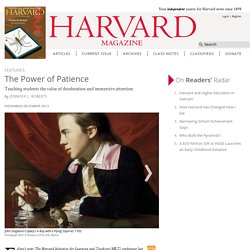
At the conference, after a panel of psychologists had discussed aspects of the “science of learning,” three speakers addressed the “art of teaching”—among them then professor of history of art and architecture Jennifer L. Roberts (now Elizabeth Cary Agassiz professor of the humanities), who also chairs the doctoral program in American Studies. Boy Brings His Class To Tears Using Just His Voice - Video - ZM Online - Today's Hit Music, Competitions, Podcasts and Concerts. TEDxSSN - Dr. Pawan Agrawal - Mumbai Dabbawalas. IBtv » Blog Archive » AEM Regional Conference 2011 The Hague – Lynn Erickson.
A new school of thought. Unlearn everything you have learnt and you might stumble upon a whole set of new truths about yourself.

Stripped of social conditioning, the world would seem a much better place, says Manish Jain, co-founder co-ordinator of Shikshantar Andolan, a people’s institute for rethinking education and development. Manish spearheads an “unschooling movement”, which has been steadily garnering followers across the country. “The school system has systematically killed our imagination,” says Manish, who believes that learning cannot be equated with school.
The Incredible Power of Not Taking Credit. Out Of the Negativity, Be the Water That Affects Positive Change - Finding Common Ground. A leader must be a "people person" Most leaders proclaim that they’re not a “people person” even though they may act that way.
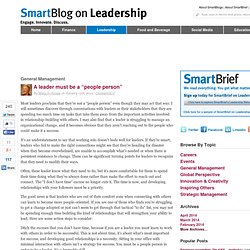
I will sometimes discover through conversations with leaders or their stakeholders that they are spending too much time on tasks that take them away from the important activities involved in relationship-building with others. 5 Habits of Innovative Educators. Habits are unconscious patterns of behavior that are acquired with frequent repetition.
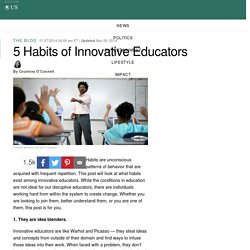
This post will look at what habits exist among innovative educators. While the conditions in education are not ideal for our disruptive educators, there are individuals working hard from within the system to create change. Whether you are looking to join them, better understand them, or you are one of them, this post is for you. 1. They are idea blenders. Concept to Classroom: Course Menu. Inquiry Learning Vs. Standardized Content: Can They Coexist? By Thom Markham As Common Core State Standards are incorporated from school to school across the country, educators are discussing their value.
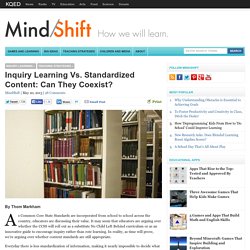
It may seem that educators are arguing over whether the CCSS will roll out as a substitute No Child Left Behind curriculum or as an innovative guide to encourage inquiry rather than rote learning. Project, Problem, and Inquiry-Based Learning. What are problem, project, and inquiry based learning?
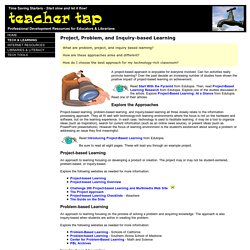
The Inquiry Page. Based on John Dewey's philosophy that education begins with the curiosity of the learner, we use a spiral path of inquiry: asking questions, investigating solutions, creating new knowledge as we gather information, discussing our discoveries and experiences, and reflecting on our new-found knowledge.
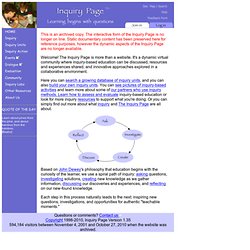
Each step in this process naturally leads to the next: inspiring new questions, investigations, and opportunities for authentic "teachable moments. " Musings of a passionate inquirer. Brain-based Learning. Definition This learning theory is based on the structure and function of the brain.

As long as the brain is not prohibited from fulfilling its normal processes, learning will occur. Please note: since this article was published, Geoffrey and Renate Caine, leaders in brain-based learning research, have modified their principles on the topic. Three Brain-Based Teaching Strategies to Build Executive Function in Students. Updated 01/2014 For young brains to retain information, they need to apply it.
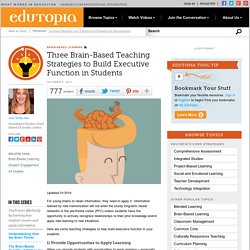
Information learned by rote memorization will not enter the sturdy long-term neural networks in the pre-frontal cortex (PFC) unless students have the opportunity to actively recognize relationships to their prior knowledge and/or apply new learning to new situations. Here are some teaching strategies to help build executive function in your students. 1) Provide Opportunities to Apply Learning When you provide students with opportunities to apply learning -- especially through authentic, personally meaningful activities -- and then provide formative assessments and feedback throughout a unit, facts move from rote memory to become part of the memory bank. Why play-based learning? ' ... for the EYLF to be implemented properly, all early childhood educators need to know what play is, why it is important, how to implement and assess a play-based program and their role in it.' Questioning practice The Early Years Learning Framework (EYLF) is built on the understanding that the principles of early childhood pedagogy (DEEWR, 2009, pp. 12-13) guide the practice of early childhood educators.

Research tells us that an educator's pedagogy is one of the most important aspects when assessing the quality of children's learning. So early childhood educators need to carefully consider and question their pedagogy and corresponding practices. In implementing the EYLF, educators should discuss and describe their understandings of the practice principles.
A Movie About Play. The Importance of Free Play for Learning. Uncategorized In an attempt to improve academic achievement, schools and districts are considering a variety of reforms including lengthening the school day, shortening vacation time and any and all interventions to improve test scores. But what is lost when a child’s life becomes increasingly scheduled? Writing for The Independent, Dr. Peter Gray makes the case for free play, arguing that in those moments of fun and freedom kids, are learning how to be creative, deal with fear, and form emotional bonds. Constructivist Theory. A major theme in the theoretical framework of Bruner is that learning is an active process in which learners construct new ideas or concepts based upon their current/past knowledge. The learner selects and transforms information, constructs hypotheses, and makes decisions, relying on a cognitive structure to do so.
Cognitive structure (i.e., schema, mental models) provides meaning and organization to experiences and allows the individual to "go beyond the information given". As far as instruction is concerned, the instructor should try and encourage students to discover principles by themselves. The instructor and student should engage in an active dialog (i.e., socratic learning).
The task of the instructor is to translate information to be learned into a format appropriate to the learner's current state of understanding. Application Bruner's constructivist theory is a general framework for instruction based upon the study of cognition. Constructivism as a Paradigm for Teaching and Learning. Www.emtech.net/construc.htm. Constructivism, Instructivism, and Related Sites The contention between student-centered and teacher-centered approaches has a long history. Constructivist Learning Theory. The Museum and the Needs of People CECA (International Committee of Museum Educators) Conference Jerusalem Israel, 15-22 October 1991 Prof. George E. Hein Lesley College. Massachusetts USA Introduction The latest catchword in educational circles is "constructivism, " applied both to learning theory and to epistemology---both to how people learn, and to the nature of knowledge.1,2 We don't need to succumb to each new fad, but we do need to think about our work in relation to theories of learning and knowledge.
So we need to ask: what is constructivism, what does it have to tell us that is new and relevant, and how do we apply it to our work? Anchored Instruction. Anchored instruction is a teaching approach that situates, or anchors, problems in authentic-like contexts that people can explore to find plausible solutions. Anchored instruction in education is closely related to problem-based and case-based learning in other fields (e.g., business, medicine), but it differs somewhat because all the information for solving anchored problems is available whereas it may not be in actual problem solving situations. Anchors are typically shown in a short video (8-to-12 minutes), which students search to find information they need for solving the embedded problems.
In a typical classroom using anchored instruction, students work together to formulate strategies for solving the subproblems embedded in the anchor. The problems are of high interest, and most students work for several days to help the main characters in the video solve the problems. Presenting anchored problems in video format has several advantages. Instructional Design: Anchored Instruction. Science Shows Making Lessons Relevant Really Matters. Education.alberta.ca/apps/aisi/literature/pdfs/bbased_learning.
Andragogy: what is it and does it help thinking about adult learning? Articles by Dr. Spencer Kagan - Cooperative Learning and Multiple Intelligences - What are the Connections? Stephen Krashen's Theory of Second Language Acquisition (Assimilação Natural - o Construtivismo no Ensino de Línguas) Www.csus.edu/indiv/g/gipej/teaparty.pdf.